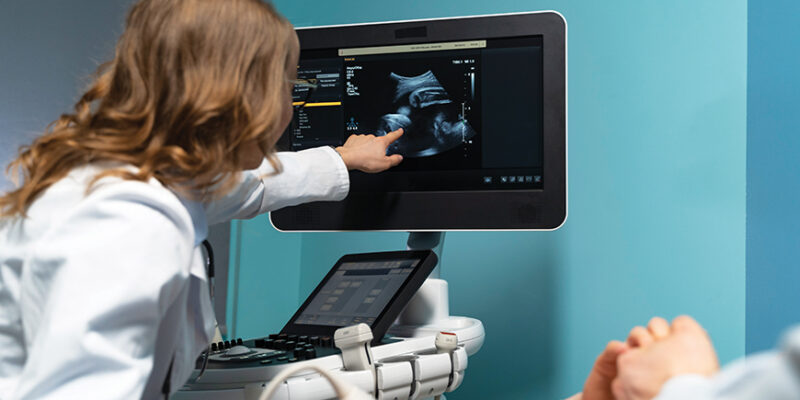Medical imaging is essential in modern healthcare, helping doctors diagnose, treat, and monitor different conditions. Ultrasound services, in particular, have revolutionised medical diagnostics and patient care. In this blog, we’ll explore how advancements in ultrasound technology are improving medical imaging, as well as its applications and benefits.
Advancements in Ultrasound Technology
The evolution of ultrasound technology has been marked by significant advancements that have expanded its capabilities and applications. Traditional ultrasound systems have been enhanced with innovations such as:
-
3D and 4D Imaging:
Modern ultrasound machines can create detailed 3D and dynamic 4D images, unlike the old flat, 2D images. These improvements offer clearer and more complete views of the body’s structures, leading to more accurate diagnoses.
-
High-Frequency Transducers:
High-frequency transducers have enhanced image resolution, making seeing small and surface-level structures easier. This improvement is especially useful in dermatology, musculoskeletal imaging, and detailed foetal assessments.
-
Elastography:
This advanced ultrasound technique measures how stiff tissues are, which can help detect conditions like liver fibrosis or breast cancer. Elastography adds useful information to traditional imaging, improving diagnostic accuracy.
-
Artificial Intelligence (AI) Integration:
AI and machine learning are being added to ultrasound systems to help with interpreting images, automating measurements, and increasing diagnostic accuracy. AI-powered ultrasound can spot subtle abnormalities that might be missed by the human eye.
Diverse Applications of Ultrasound Services
Ultrasound services have a wide range of applications across various medical specialties. Some of the key areas where ultrasound has made a significant impact include:
-
Obstetrics and Gynecology:
Ultrasound is widely known for its use in obstetrics, helping to monitor foetal development, detect anomalies, and guide interventions during pregnancy. It is also crucial in gynaecology for assessing conditions like ovarian cysts, fibroids, and endometriosis.
-
Cardiology:
Echocardiography, a special type of ultrasound, is essential in cardiology for examining the heart’s structure and function. It helps diagnose conditions such as heart valve problems, congenital heart defects, and cardiomyopathies, and guides certain procedures.
-
Radiology and General Imaging:
In radiology, ultrasound helps image soft tissues, organs, and blood vessels. It is especially useful for examining abdominal organs, thyroid glands, and blood vessels, and for guiding biopsies and other minor procedures. Alongside other imaging techniques like MRI and Dexa Scan, ultrasound provides a comprehensive view of the patient’s condition.
-
Emergency Medicine:
Point-of-care ultrasound (POCUS) is crucial in emergency medicine. It quickly helps assess conditions like internal bleeding, pneumothorax, and cardiac tamponade, enabling fast and accurate decision-making in critical situations.
-
Musculoskeletal Imaging:
Ultrasound is becoming more common for diagnosing and managing musculoskeletal issues, like tendonitis, ligament injuries, and joint problems. It offers real-time imaging during movement, which helps make accurate assessments.
-
Anesthesiology and Pain Management:
Ultrasound-guided nerve blocks and injections are now commonly used in anesthesiology and pain management. This method improves the accuracy and safety of regional anaesthesia and pain relief procedures.
Benefits of Ultrasound Services
The widespread adoption of ultrasound services in medical imaging is driven by numerous benefits that make it an invaluable diagnostic tool:
-
Non-Invasive and Safe:
Ultrasound is a safe, non-invasive imaging method that uses sound waves instead of radiation. This makes it suitable for patients of all ages, including pregnant women and children.
-
Real-Time Imaging:
Ultrasound offers real-time imaging, letting doctors see dynamic processes and make quick assessments. This is especially helpful for procedures that need real-time guidance, like biopsies and catheter placements.
-
Cost-Effective:
Ultrasound is more affordable than other imaging methods like CT and MRI. Its lower cost makes it accessible to more patients and helps reduce the financial burden on healthcare systems.
-
Portability and Accessibility:
Modern ultrasound devices are portable, allowing imaging services to be brought to patients in various settings, including remote and underserved areas. This improves healthcare delivery and patient outcomes.
-
Versatility:
Ultrasound can image many types of tissues and structures, from surface muscles and tendons to deep organs and blood vessels. Its versatility makes it a useful tool in various medical specialties.
-
Patient Comfort:
Ultrasound exams are usually well-tolerated by patients. They are quick, painless, and don’t need any special preparation or recovery time, leading to a positive experience.
The Future of Ultrasound Technology
In the future, innovations in technology will continue to influence ultrasound services to become even better. New technologies, particularly AI, are improving ultrasound imaging by aiding in more accurate interpretation of the images and standardising the results to minimise variations between different operators. AI can also help in tasks such as foetal biometrics measurements, which will assist in imaging.
One of the new opportunities is using ultrasound simultaneously with other types of imaging, like MRI or CT. These hybrid systems give extra data and a more holistic perspective of the patient, which can help with specific detection and help create tailored care strategies.
Conclusion
Ultrasound services have transformed medical imaging by providing a safe, non-invasive, and versatile diagnostic tool accessible to many patients. With ongoing technological advancements and growing use in various medical fields, ultrasound will play an even bigger role in the future of healthcare. Embracing these innovations promises better patient outcomes and more efficient healthcare delivery








Comments